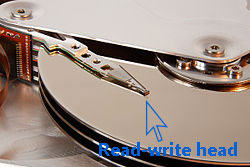This article offers a detailed introduction to magnetic head, including its main types and the issue head crash.
Hard disk head, a key component in hard disk, is used to read data. Its main function is transforming magnetic information which are stored on the hard disk into electrical signal. It makes use of the principle that the resistance of some special materials will be changed to read and write the data on the disk. The hard disk head quality will affect the hard disk storage density.

For most of the computers, in the process of exchanging data with the hard drive, the read speed is much faster than writing. Reading and writing operations are of different characteristics. Those factors prompt the hard disk vendors to develop the head that uses different working principles in reading and writing.
Due to the nature of magnetic head, it asks for rather high demand for the magnetic induction sensitivity and precision.
Types of Magnetic Head
The conventional head is electromagnetic head which combines the read and write function together. The magnetoresistive ( MR ) head owns detachable head structure. The writing head in it uses the traditional electromagnetic head and the reading head applies the MR head. Furthermore, the separated head uses the magnetoresistive ( MR ) effect which changes the resistance of a material in the presence of magnetic field. As a result, it can be very sensitive to the changeable signals. And the accuracy of reading data can also be improved. In addition, the signal amplitude to be read has nothing to do with the track width. Then the disk density will also be enhanced.
The MR head has been widely applied. And the GMR which has better quality in magnetoresistive effect will be more popular in the future.
TFI Head (Thin-film inductive head)
Hard disk adopts the TFI read/write technology from 1990 to 1995. And the TFI head can be described as a winding magnetic core. The induced voltage will be produced when the disk goes through the magnetic core. With the improvement of magnetic sensitivity, the writing ability will be weakened. Thus the reading head of the TFI will run of its ability.
AMR Head (Anisotropic Magneto Resistive head)
In 1991, IBM proposed a new technology, namely AMR head, which is based on MR head. In the process of connecting with the rotating disk, the head can read the data by sensing the change of magnetic field. In the hard disk, capacity of single disk and the technology of magnetic head will restrain each other as well as promote each other.
In the mid 90s, the Seagate launched hard disk which is using AMR magnetic head. AMR magnetic head adopts the TFI head to write, but uses thin magnetic materials to read.
The resistance of the thin strip will change according to the magnetic field. And then generate strong signal. AMR magnetic head further improves the surface density, and reduces the number of components. Due to the limitation in AMR technology, it can support 3.3 GB/square inch’s recording density to the most. Thus the sensitivity of AMR magnetic head also has limitations. It contributes to the born of GMR head.
Let’s take a look at the Seagate 8TB NAS HDD if you’re interested.
GMR Head (Giant Magnetoresistance Head)
GMR head has inherited the reading and writing technology in TFI head and AMR head, but it is more sensitive than the former. The GMR head is composed by 4 layers of conductive materials and magnetic thin materials. The GMR sensor owns high sensitivity than the AMR head. Thus it can improve the density and performance of the disk.
Magnetic Tape head
Sound recorder works via electromagnetic induction principle, and the head of sound recorder is actually a U-shaped electromagnet. When the recorder is working, sound coming from paper disc of microphone becomes induced current after shaking, and then transferred to head via amplification circuit. The head closely cling to the tape, and the induced current magnetizes the head, becoming a electromagnet. Before recording, we should demagnetize the tape so as to thoroughly erase original signals. Recording head and playback head on common sound recorders is in fact the same head, and they are just connected to different positions. When recording, the head is connected with microphone. When playing, it is connected with horn.
Head Crash
A head crash is hard-disk malfunction. And it happens when a hard disk read/write head touches its rotating disk platter. What’s more, this kind of crash will lead to long term and even irrevocable damage to the magnetic media on the platter surface.
Head crash is one of the main causes for hard drive corruption mentioned in Data Recovery From Corrupted Internal Hard Disk – How To Do ( part two: 7 Main Causes for Hard Drive Corruption ).
A head often moves on a wafery veil of air flow that included in the surface of its platter. The highest layer of the platter is made of some special material that does the function just like a sliding agent. What lies under is a layer of crackle carbon. These two layers( rather hard in quality ) can help the magnetic layer ( made from thin film materials ) get rid of most fortuitous touches of the read-write head.
A head crash can be caused by a force that gives power on the platters from the heads to break into the magnetic storage layer. A micronic dust or other dirt, violent shake or oscillation, or accidentally falling down a working disk can make a head to bounce against its disk, damaging the thin magnetic covering on the head, and then destroying the heads.